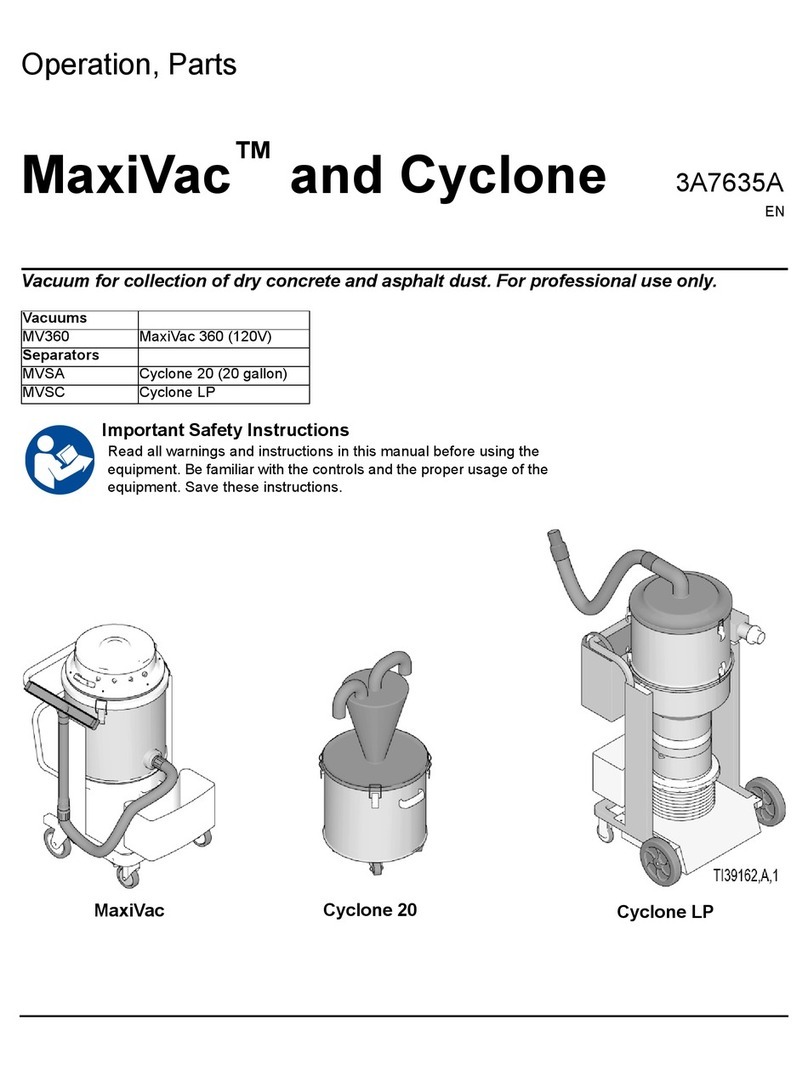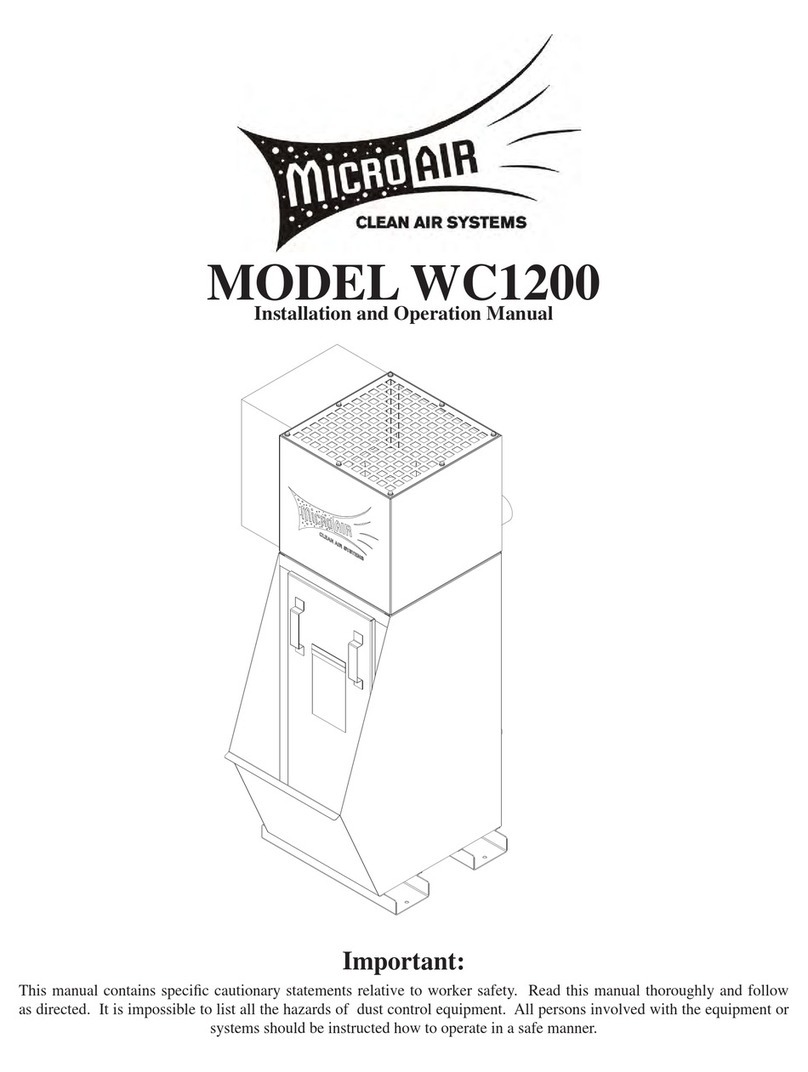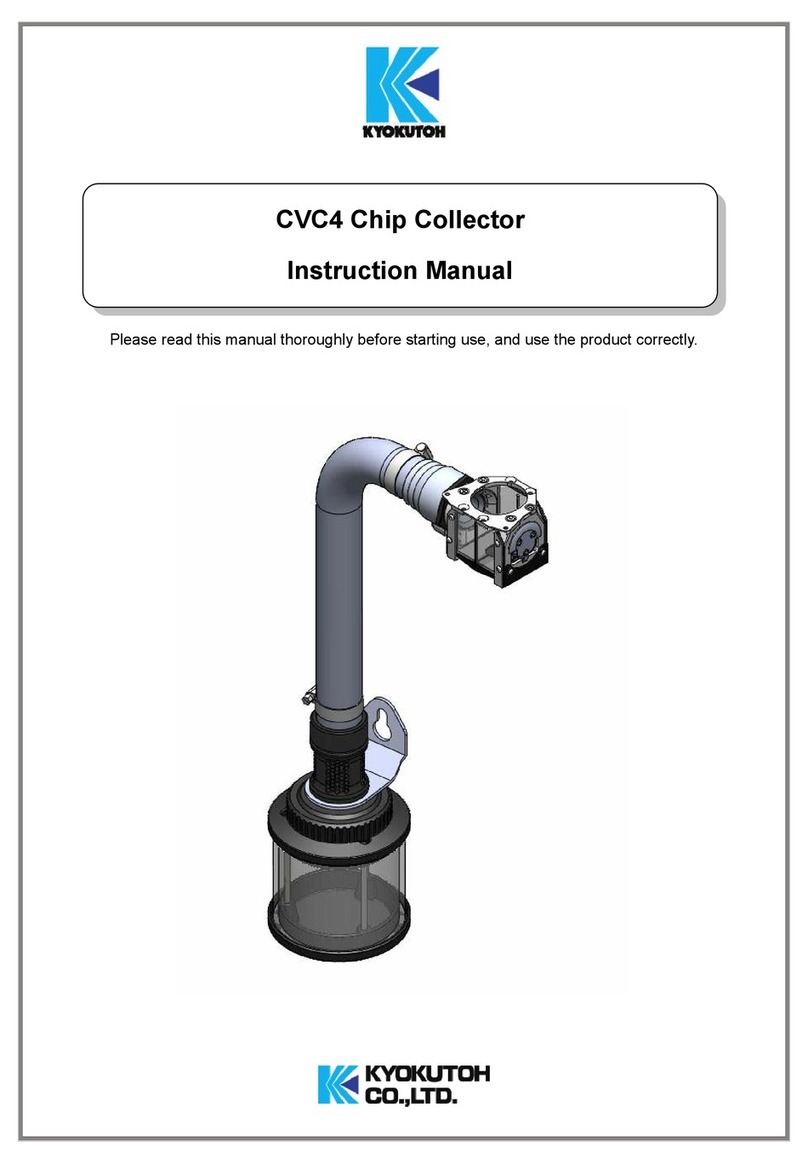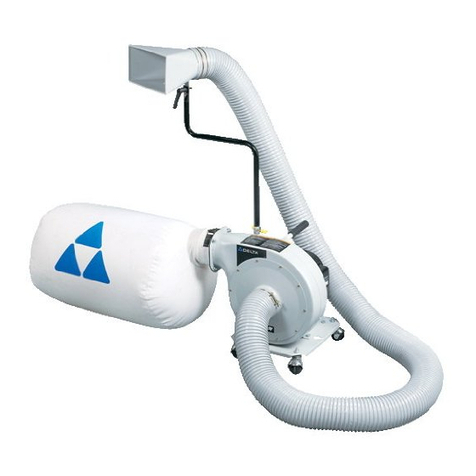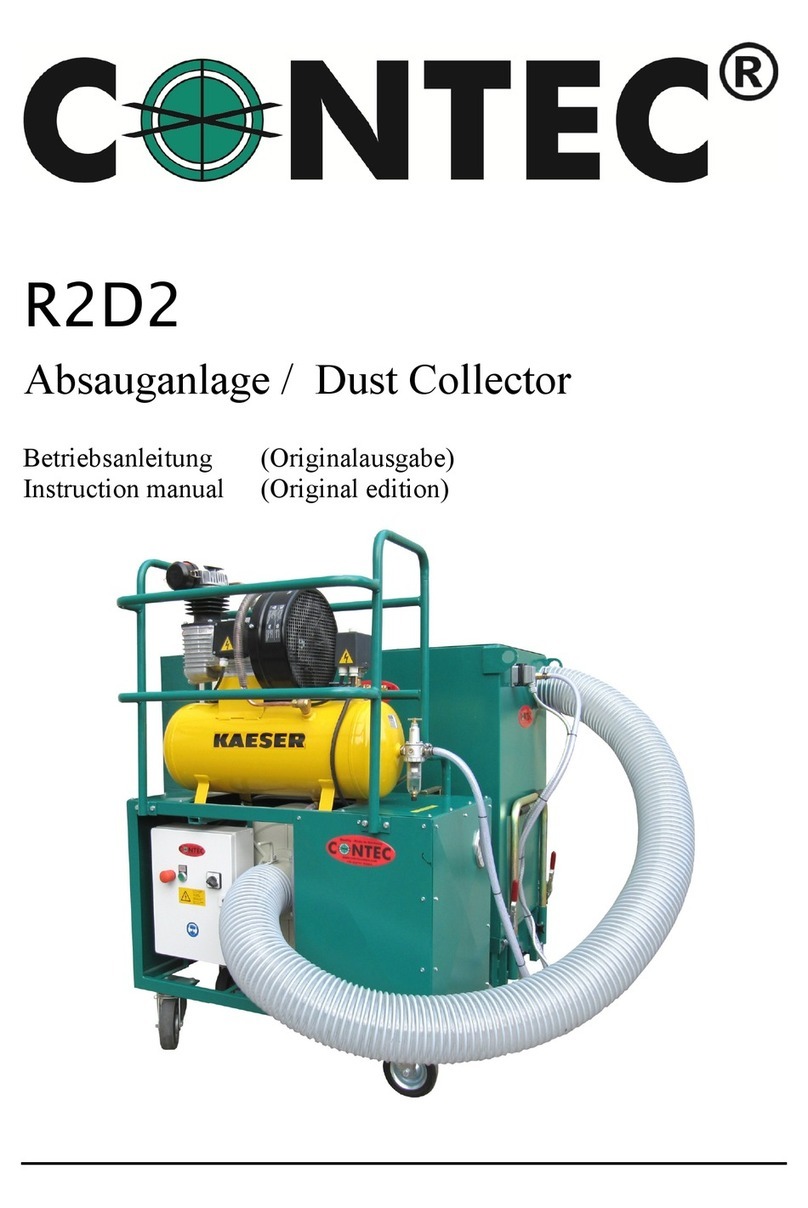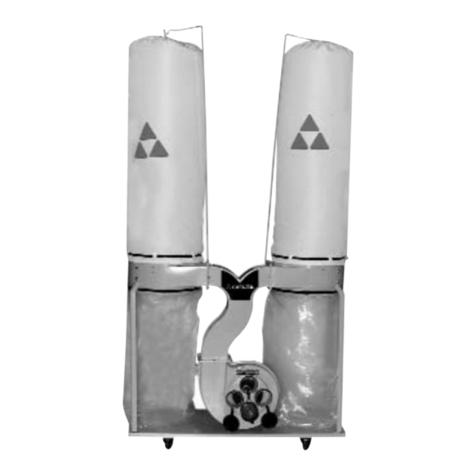Marco DUSTMASTER User manual

Before using this equipment, read, understand and follow all instructions
in the Operator’s Manuals provided with this equipment. If the user and/
or assistants cannot read or understand the warnings and instructions,
the employer of the user and/or assistants must provide adequate and necessary training to
ensure proper operation and compliance with all safety procedures pertaining to this equipment. If
Operator’s Manuals have been lost, please visit www.marco.us, or contact Marco at 563.324.2519
for replacements. Failure to comply with the above warning could result in death or serious injury.
OPERATOR’S MANUAL
DUSTMASTER®28,000 CFM TIER 4
DIESEL DUST COLLECTORS

Dustmaster® 28,000 CFM Tier 4 Diesel Dust Collectors
1
Company Profile
Since 1944, Marco has developed a strong tradition of providing innovative and reliable products and services to the
surface preparation and protective coatings industries. We are the world’s premier provider of Abrasives, Blasting,
Coating, Dust Collectors, Engineered Systems, Rental, Safety, Service, Repair, & Modernization, and Vacuums.
Through innovative designs and a total commitment to quality, Marco manufactures products that increase production
rates, create a safer workplace, and reduce maintenance costs. Marco’s industry experience, manufacturing
capabilities, legendary customer service, product availability, logistics services, and technology leadership is your
assurance that we deliver high quality products and services, providing the best value to you, our customer.
The Marco Difference
•
Industry Experience – With Marco on your team, you have access to expertise which can only come from
decades of industry leadership. We have organized our engineering department, production specialists, customer
operations, and safety support into a “Center of Competence.” As a Marco customer, you have access to hundreds
of years of cumulative experience related to your operations.
•
Manufacturing Excellence – Marco is a U.S. based, ISO 9001:2008 certified manufacturer of equipment for the
Surface Preparation and Protective Coatings industries. Marco’s engineers benchmark the industry to ensure that
we design and manufacture superior products that set the “Gold Standard” for performance, safety, and quality.
• Legendary
Customer Service
–
Marco’s legendary customer service team is staffed by friendly, highly-trained
individuals who are focused on providing the highest level of product support, order accuracy, and customer
satisfaction.
•
Product Availability – We stock over 10,000 SKU’s and have more than 45 shipping locations to serve North
American and International markets for all major brands of blasting and coating equipment. As the largest provider of
surface preparation and protective coatings equipment in the world, our inventory levels and product availability are
unmatched.
•
Logistics Services – Marco’s in-house logistics team is dedicated to moving your shipment anywhere in the world.
We move more than 14,000 truckloads every year, allowing you to save on freight costs by leveraging our buying
power. Lower your process costs with a single invoice, which includes product and freight.
•
Technology Leadership – Our website provides: Operator’s Manuals, Part Numbers and Schematics Guides, SDS
information, and Features & Specifications Guides, providing access to information 24/7. Our Extranet application
allows you to receive quotes and place orders online. Our Intranet maintains a complete record of your purchase
history to assist with ongoing support of your existing equipment and future purchasing decisions.
Vision Statement
Marco is the world’s premier provider of Abrasives, Blasting, Coating, Dust Collectors, Engineered Systems, Rental,
Safety, Service, Repair, & Modernization, and Vacuums.
Mission Statement
Marco provides strong leadership and innovation to the surface preparation and protective coatings industries.
We dedicate our efforts to the continuous improvement of our products, services, processes, people, and most
importantly, the quality of our customer’s experience.
Quality Statement
Marco is committed to providing superior quality in the design, manufacturing, distribution, rental, service, and repair
of our products. Our ISO 9001:2008 certification extends throughout all operations in all locations. Continuous
improvement of our processes and supply chain Integration comprise the core of our business strategy for delivering
exceptional quality and value in all Marco products and services.
Management Philosophy
We are a company dedicated to the success of every customer and associate. We discuss, debate, challenge,
measure, and test our ideas. We will be boundless and limitless in our passion to improve. Through sound
leadership and dedicated associates, we will ensure a long term, profitable future for Marco, our associates,
customers, and suppliers.

Dustmaster® 28,000 CFM Tier 4 Diesel Dust Collectors 2
DEFINITION OF TERMS
This is an example of a warning. This indicates a
potentially hazardous situation which, if not avoided,
could result in death or serious injury.
This is an example of a notice. This indicates policy
or practice directly related to safety of personnel or
protection of property.
This is an example of danger. This indicates an
imminently hazardous situation which, if not avoided, will
result in death or serious injury.
This is an example of a caution. This indicates a
potentially hazardous situation which, if not avoided,
may result in minor or moderate injury. It can also be
used to alert against unsafe practices.
Company Prole . . . . . . . . . . . . . . . . . . . . . . . . . . 1
Denition of Terms . . . . . . . . . . . . . . . . . . . . . . . 2
Hazard Identications . . . . . . . . . . . . . . . . . . . . 3
Air & Abrasive Consumption Chart . . . . . . . . 6
Daily Pre-Operation Checklist . . . . . . . . . . . . . 8
Operating Instructions . . . . . . . . . . . . . . . . . . . . 9
Description . . . . . . . . . . . . . . . . . . . . . . . . . . . . . . 9
Operational Requirements . . . . . . . . . . . . . . . . . . 9
Operating Instructions . . . . . . . . . . . . . . . . . . . . . 9
Connect Duct Hose . . . . . . . . . . . . . . . . . . . . . . 12
Pre-Startup . . . . . . . . . . . . . . . . . . . . . . . . . . . . . 13
Unit Startup & Shutdown . . . . . . . . . . . . . . . . . . 14
Pulser System Startup . . . . . . . . . . . . . . . . . . . . 15
Auger Clean-out Startup. . . . . . . . . . . . . . . . . . . 16
Activating & Deactivating Pneumatic Ball
Vibrators . . . . . . . . . . . . . . . . . . . . . . . . . . . . . . . 17
Reading Magnehelic Gauge . . . . . . . . . . . . . . . . 18
Lubricate Grease Points . . . . . . . . . . . . . . . . . . . 19
Specications . . . . . . . . . . . . . . . . . . . . . . . . . . . 20
TABLE OF CONTENTS
Maintenance . . . . . . . . . . . . . . . . . . . . . . . . . . . . . . . 21
Remove & Install Fan Drive Belt. . . . . . . . . . . . . . . . 21
Adjust Tension of Fan Drive Belt . . . . . . . . . . . . . . . 22
Adjust Main Auger Drive Chain. . . . . . . . . . . . . . . . . 23
Adjust Discharge Auger Drive Chain . . . . . . . . . . . . 24
Adjust Pulse Separation . . . . . . . . . . . . . . . . . . . . . . 25
Remove & Install Hydraulic Oil Filter . . . . . . . . . . . . 26
Remove & Install Dust Collector Filter Cartridges . . 27
Hazard Identification Decals. . . . . . . . . . . . . . . . . . . 28
Troubleshooting . . . . . . . . . . . . . . . . . . . . . . . . . . . . 30
Limited Warranty . . . . . . . . . . . . . . . . . . . . . . . . . . .34
Disclaimer of Warranty . . . . . . . . . . . . . . . . . . . . . . . 34
Exclusive Remedy for Warranty Claims . . . . . . . . . . 34
Limitation of Remedies . . . . . . . . . . . . . . . . . . . . . . . 34

Dustmaster® 28,000 CFM Tier 4 Diesel Dust Collectors
3
Failure to comply with ANY WARNING listed below could result in death or serious injury.
OSHA sets exposure limits to protect workers from exposure to respirable crystalline silica, 29 CFR 1910.1053.
Airborne dust could increase the exposure levels beyond permissible limits. Breathing dust containing silica
could cause silicosis, a fatal lung disease. Breathing dust during abrasive blasting operations, post-blast cleaning
operations, and/or servicing equipment within the abrasive blasting area may expose an individual to conditions
that could cause asbestosis, lead poisoning and/or other serious or fatal diseases. Harmful dust containing toxic
material from abrasives or surfaces being abrasive blasted can remain suspended in the air for long periods of
time after abrasive blasting has ceased. A NIOSH-approved, well-maintained, respirator designed for the specific
operation being performed must be used by anyone abrasive blasting, handling or using the abrasive, and
anyone in the area of the dust.
Contact NIOSH and OSHA offices to determine the proper respirator for your specific application. The air supplied
to the respirator must be at least Grade D quality as described in Compressed Gas Association Commodity
Specification G-7.1 and as specified by OSHA Regulation 1910.134. Ensure air filter and respirator system hoses
are not connected to non-air sources or in-plant lines that may contain nitrogen, oxygen, acetylene or other
non-breathable gases. Before removing respirator, use an air monitoring instrument to determine if the
atmosphere is safe to breathe.
You must comply with all OSHA, local, City, State, Province, Country and jurisdiction regulations, ordinances and
standards, related to your particular work area and environment. Keep unprotected individuals out of the work
area.
Abrasive blasting operators must receive thorough training on the use of abrasive resistant attire which includes:
supplied-air respirator, abrasive blasting suit, safety shoes, gloves, ear protection and eye protection. Protect the
operator and bystanders by complying with NIOSH and OSHA Safety Standards.
Inspect all equipment for wear or damage before and after each use. Failure to use Original Equipment
Manufacturer repair parts and failure to immediately replace worn or damaged components could void warranties
and cause malfunctions.
OSHA requires abrasive blasting nozzles be equipped with an operating valve, which shall be designed to be
held open only by continuous hand pressure and shall close immediately upon release of hand pressure (i.e., a
“deadman” control). The valve shall not be modified in any manner that would allow it to remain open without the
application of continuous hand pressure by the operator. Failure to comply with the above warning could result in
release of high speed abrasive and compressed air resulting in death or serious injury. OSHA 29CFR 1910.244(b)
Point the abrasive blasting nozzle only at the surface being abrasive blasted. Never point the abrasive blasting
nozzle or abrasive stream at yourself or others.
Unless otherwise specified, maximum working pressure of abrasive blasting pots and related components must
not exceed 150 psi. Exceeding maximum working pressure of 150 psi could cause the abrasive blasting pot and
components to burst. Failure to comply with the above warning could result in death or serious injury.
Never weld, grind or drill on the abrasive blasting pot (or any pressure vessel). Doing so will void ASME
certification and manufacturer’s warranty. Welding, grinding or drilling on the abrasive blasting pot (or any pressure
vessel) could weaken the vessel causing it to burst. Failure to comply with the above warning could result in death
or serious injury. (ASME Pressure Vessel Code, Section VIII, Division 1)
This equipment is not intended for use in any area that might be considered a hazardous location, as described
in the National Electric Code NFPA 70, Article 500. Use of this equipment in a hazardous location could cause an
explosion or electrocution.
Never attempt to move an abrasive blasting pot containing abrasive. Never attempt to manually move abrasive
blasting pots greater than 6.5 cubic foot capacity. Always use at least two capable people to manually move an
abrasive blasting pot on flat, smooth surfaces. A mechanical lifting device must be used if an abrasive blasting pot
is moved in any other manner.
HAZARD IDENTIFICATIONS

Dustmaster® 28,000 CFM Tier 4 Diesel Dust Collectors 4
HAZARD IDENTIFICATIONS
Failure to comply with ANY WARNING listed below could result in death or serious injury.
This product is not for use in wet environments. Always use a Ground Fault Interrupter Circuit (GFIC) for
all electrical power source connections. Use of this product in wet environments could create a shock or
electrocution hazard.
Frozen moisture could cause restrictions and obstructions in pneumatic control lines. Any restriction or
obstruction in the pneumatic control lines could prevent the proper activation and deactivation of the remote
control system, resulting in the release of high speed abrasive and compressed air. In conditions where moisture
may freeze in the control lines an antifreeze injection system approved for this application can be installed.
Do not cut, obstruct, restrict or pinch pneumatic control lines. Doing so could prevent the proper activation and
deactivation of the remote control system, resulting in the release of high speed abrasive and compressed air.
Use of Marco remote control switches with other manufacturer’s remote control systems could cause unintended
activation of remote control systems resulting in the release of high speed abrasive and compressed air. Only
Marco remote control switches should be used with Marco remote control systems.
Always be certain to have secure footing when abrasive blasting. There is a recoil hazard when abrasive blasting
starts that may cause user to fall and misdirect the abrasive stream at operator or bystander.
Never use an abrasive blasting pot or attachments as a climbing device. The person could slip and fall. The
abrasive blasting pot could become unstable and tip over.
For equipment manufactured by entities other than Marco, you must consult the Original Equipment Manufacturer
operator’s manuals, information, training, instructions and warnings, for the proper and intended use of all
equipment.
Flammable fumes, such as solvent and paint fumes in the work area can present an ignition or explosion hazard
if allowed to collect in adequate concentrations. To reduce conditions that could result in a fire or an explosion,
provide adequate ventilation, eliminate all ignition or spark sources, keep the work area free of debris, store
solvents and solvent contaminated rags in approved containers, follow proper grounding procedures, do not
plug/unplug power cord or turn on/off power switches when flammable fumes are present, keep a working fire
extinguisher or provide another fire suppression system in the work area. Cease all operations and correct
condition if a spark or ignition source is identified during operation.
Always depressurize the entire system, disconnect all power sources and lockout/tagout all components before
any maintenance or troubleshooting is attempted. Failure to comply with the above warning could cause electrical
shock and inadvertent activation of equipment resulting in death or serious injury.
Moving parts can present an area where crushing, pinching, entanglement or amputation may occur. Do not
place body parts or foreign objects in any area where there are moving parts.
Surfaces of heated supply tanks, drums and/or lines as well as the adjoining plumbing may become hot during
normal use. Do not touch these heated surfaces without proper protection. Deactivate and allow sufficient time for
all surfaces to cool before attempting any maintenance.
High-pressure fluid from gun, hose leaks, or ruptured components can pierce skin and can cause a serious injury
that may result in amputation. Do not point gun or spray tip at anyone or at any part of the body. Keep clear
of any leaks or ruptures. Depressurize the entire system before attempting cleaning, inspecting, or servicing
equipment.
Exposure to toxic fluids or fumes may occur during the normal operation of this system. Before attempting to
fill, use, or service this system, read SDS’s to know the specific hazards of the fluids you are using. Always use
proper Personal Protective Equipment when attempting to fill, use, or service this system.
The use of this product for any purpose other than originally intended or altered from its original design is
prohibited.
Never hang objects from the abrasive blasting pot handle. Doing so may cause the abrasive blasting pot to
become unstable and tip over.

Dustmaster® 28,000 CFM Tier 4 Diesel Dust Collectors
5
HAZARD IDENTIFICATIONS
Failure to comply with ANY CAUTION listed below may result in minor or moderate injury.
Static electricity can be generated by abrasive moving through the abrasive blasting hose causing a shock
hazard. Prior to use, ground the abrasive blasting pot and abrasive blasting nozzle to dissipate static electricity.
High decibel noise levels are generated during the abrasive blasting process which may cause loss of hearing.
Ensure appropriate Personal Protective Equipment and hearing protection is in use.
Failure to comply with ANY NOTICE listed below could pose a hazard to personnel or property.
See Air & Abrasive Consumption Chart for estimated abrasive consumption rates and required air flow (cubic feet
per minute). Your system must meet these minimum requirements to ensure proper function and performance.
Always use abrasive that is dry and properly screened. This will reduce the potential for obstructions to enter the
remote control system, abrasive metering valve and abrasive blasting nozzle.
Moisture build-up occurs when air is compressed. Any moisture within the abrasive blasting system will cause
abrasive to clump, clogging metering valves, hoses and nozzles. Install an appropriately sized moisture separator
at the inlet of the abrasive blasting system. Leave the moisture separator petcock slightly open to allow for
constant release of water. If insufficient volume of air exists and petcock is unable to be left open (at all times)
petcock should be opened frequently to release water.
To reduce abrasive intrusion in the air supply hose, depressurize the abrasive blasting pot before shutting off air
supply from compressor.
Inspect abrasive blasting nozzle before placing into service. Damage to abrasive blasting nozzle liner or
jacket may occur during shipping. If you receive a damaged abrasive blasting nozzle, contact your distributor
immediately for replacement. Abrasive blasting nozzles placed into service may not be returned. Abrasive blasting
nozzle liners are made of fragile materials and can be damaged by rough handling and striking against hard
surfaces. Never use a damaged abrasive blasting nozzle.
Abrasive blasting at optimal pressure for the abrasive used is critical to productivity. Example: For an abrasive
with an optimal abrasive blasting pressure of 100 psi at the abrasive blasting nozzle, one pound per square inch
of pressure loss will reduce abrasive blasting efficiency by 1.5%. A 10 psi reduction in air pressure will cause a
15% loss of efficiency. Use a Needle Pressure Gauge to identify pressure drops in your system. Consult with your
abrasive supplier for the requirements of your abrasive.
Replace abrasive blasting nozzle if liner or jacket is cracked or damaged. Replace abrasive blasting nozzle if
original orifice size has worn 1/16” or more. Determine abrasive blasting nozzle wear by inserting a drill bit 1/16”
larger than original size of abrasive blasting nozzle orifice. If the drill bit passes through abrasive blasting nozzle,
replacement is needed.

Dustmaster® 28,000 CFM Tier 4 Diesel Dust Collectors 6
Failure to comply with ANY NOTICE listed below could pose a hazard to personnel or property.
See Air & Abrasive Consumption Chart for estimated abrasive consumption rates and required air flow
(cubic feet per minute). Your system must meet these minimum requirements to ensure proper function and
performance.
When it comes to air & abrasive mixtures, more is not necessarily better. Optimum abrasive blasting efficiency
takes place when a lean air & abrasive mixture is used. To correctly set the abrasive metering valve, begin
with the valve fully closed and slowly increase the amount of abrasive entering the airstream. As you increase
the abrasive flow, watch for a “blue flame” at the exit of the abrasive blasting nozzle. Faster cutting, reduced
abrasive consumption and lower clean up costs, are benefits of the “blue flame”.
Abrasive blasting at optimal pressure for the abrasive used is critical to productivity. Example: For an abrasive
with an optimal abrasive blasting pressure of 100 psi at the abrasive blasting nozzle, one pound per square inch
of pressure loss will reduce abrasive blasting efficiency by 1.5%. A 10 psi reduction in air pressure will cause a
15% loss of efficiency. Use a Needle Pressure Gauge to identify pressure drops in your system. Consult with
your abrasive supplier for the requirements of your abrasive.
*Abrasive consumption is based on abrasive with a bulk density of 100 lbs per Cubic Foot
Air & Abrasive Consumption Chart*
Nozzle
Orifice
Pressure at the Nozzle (PSI) Air (in cfm), Abrasive
& Compressor
Requirements
50 60 70 80 90 100 125 140
No. 2
(1/8ˮ)
11
67
2.5
13
77
3
15
88
3.5
17
101
4
18
112
4.5
20
123
5
25
152
5.5
28
170
6.2
Air (cfm)
Abrasive (lbs/hr)
Compressor Horsepower
No. 3
(3/16ˮ)
26
150
6
30
171
7
33
196
8
38
216
9
41
238
10
45
264
10
55
319
12
62
357
13
Air (cfm)
Abrasive (lbs/hr)
Compressor Horsepower
No. 4
(1/4ˮ)
47
268
11
54
312
12
61
354
14
68
408
16
74
448
17
81
494
18
98
608
22
110
681
25
Air (cfm)
Abrasive (lbs/hr)
Compressor Horsepower
No. 5
(5/16ˮ)
77
468
18
89
534
20
101
604
23
113
672
26
126
740
28
137
812
31
168
982
37
188
1100
41
Air (cfm)
Abrasive (lbs/hr)
Compressor Horsepower
No. 6
(3/8ˮ)
108
668
24
126
764
28
143
864
32
161
960
36
173
1052
39
196
1152
44
237
1393
52
265
1560
58
Air (cfm)
Abrasive (lbs/hr)
Compressor Horsepower
No. 7
(7/16ˮ)
147
896
33
170
1032
38
194
1176
44
217
1312
49
240
1448
54
254
1584
57
314
1931
69
352
2163
77
Air (cfm)
Abrasive (lbs/hr)
Compressor Horsepower
No. 8
(1/2ˮ)
195
1160
44
224
1336
50
252
1512
56
280
1680
63
309
1856
69
338
2024
75
409
2459
90
458
2754
101
Air (cfm)
Abrasive (lbs/hr)
Compressor Horsepower
No. 10
(5/8ˮ)
308
1875
68.5
356
2140
79.5
404
2422
90
452
2690
100.5
504
2973
112
548
3250
122
663
3932
146
742
4405
165
Air (cfm)
Abrasive (lbs/hr)
Compressor Horsepower
No. 12
(3/4ˮ)
432
2672
96
504
3056
112
572
3456
127
644
3840
143
692
4208
154
784
4608
174.5
948
5570
209
1062
6238
236
Air (cfm)
Abrasive (lbs/hr)
Compressor Horsepower
Inspect abrasive
blasting nozzle before
placing into service.
Damage to abrasive
blasting nozzle liner
or jacket may occur
during shipping. If you
receive a damaged
abrasive blasting nozzle,
contact your distributor
immediately for
replacement. Abrasive
blasting nozzles placed
into service may not
be returned. Abrasive
blasting nozzle liners
are made of fragile
materials and can be
damaged by rough
handling and striking
against hard surfaces.
Never use a damaged
abrasive blasting nozzle.
Replace abrasive
blasting nozzle if liner
or jacket is cracked
or damaged. Replace
abrasive blasting nozzle
if original orifice size
has worn 1/16” or more.
Determine abrasive
blasting nozzle wear by
inserting a drill bit 1/16”
larger than original size
of abrasive blasting
nozzle orifice. If the
drill bit passes through
abrasive blasting nozzle,
replacement is needed.
“Blue Flame”
AIR & ABRASIVE CONSUMPTION CHART

Dustmaster® 28,000 CFM Tier 4 Diesel Dust Collectors
7
“THE BIG PICTURE”
1
2
3
4
5
6
5
5
5
4
7

Dustmaster® 28,000 CFM Tier 4 Diesel Dust Collectors 8
DAILY PRE-OPERATION CHECKLIST
Daily Pre-operation Checklist
1. Dust Collector
2. Discharge Collection Drum
3. Air Compressor
4. Air Hose
5. Safety Cable
6. Aftercooler*
7. Duct Hose
* Optional or alternative device.
Ask your Marco Representative
for more details.
Dust Collector – Position Dust Collector (1) as close to the containment area
as possible. Use short lengths of duct hose, minimizing curves and bends for
improved performance. Perform daily lubrication. (See Lubricate Grease Points.)
Check all uid levels. Connect a 3/4” I.D. air supply line to Filter Regulator of
Pulser system. Open Air Inlet Door(s) and connect duct hose. (See Connect
Duct Hose). Ensure all unused Air Inlet Doors are closed securely.
Discharge Collection Container – Empty Discharge Collection Container (2)
before use. Position as shown. Install optional Drum Cover and six inch Duct
Hose.
Air Compressor – Select an Air Compressor (3) of adequate size to support
all equipment requirements. Before connecting Air Hose (4), sample the air
being produced by the air compressor (3) to ensure it is free of petroleum
contaminants.
Air Hose, and Air Hose Couplings & Gaskets – Select Air Hoses (4) of
sufficient size to support all subsequent volumetric requirements and with a
sufficient PSI (pound per square inch) rating. Inspect all Air Hoses (4), and Air
Hose Couplings & Gaskets (7) for damage or wear. Repair or replace damaged
or worn components.
Safety Cables – Install a Safety Cable (5) at each Air Hose (4) connection
points.
Aftercooler and Moisture Separator – Ensure Aftercooler (6) is positioned on
stable ground. Drain after each use.
Duct Hose – Ensure Duct Hose (7) is serviceble and secured to Dust Collector
and containment area.

Dustmaster® 28,000 CFM Tier 4 Diesel Dust Collectors
9
OPERATING INSTRUCTIONS
You must comply
with all OSHA, local,
City, State, Province,
Country and jurisdiction
regulations, ordinances
and standards, related
to your particular work
area and environment.
Keep unprotected
individuals out of the
work area. Failure to
comply with the above
warning could result in
death or serious injury.
W-503
Ensure the surface is
level, stable, and is
sufficient to support the
weight of the Device
or System. Uneven or
unstable surfaces, and/
or surfaces that cannot
support the gross
weight of the Device
or System could cause
the Device or System
to overturn. Failure to
comply with the above
warning could result in
death or serious injury.
W-575
For equipment
manufactured by entities
other than Marco,
you must consult the
Original Equipment
Manufacturer operator’s
manuals, information,
training, instructions
and warnings, for the
proper and intended
use of all equipment.
Failure to comply with
the above warning
could result in death or
serious injury.
W-511
Description
A dust collector creates an engineered air flow in an enclosure, providing ventilation and
collecting airborne dust and debris. Abrasive blasting performed in an enclosure requires
a dust management system for compliance with OSHA regulations governing the work
site. Removing airborne dust and debris from an enclosure improves work site safety and
visibility, increasing production rates. The Dustmaster®28,000 CFM Tier 4 Diesel Dust
Collectors have a reverse incline blade fan matched to a 120 horsepower Perkins®Tier 4
Final diesel engine to generate up to 28,000 CFM of air flow. Typical applications include
blast rooms, blast yards, bridges, oil refineries, offshore platforms, pipelines, shipyards,
storage tanks, and water treatment plants.
Operational Requirements
• 12-Volt DC power source
• 24 CFM @ 90 PSI regulated filtered air.
The following may cause safety hazards or reduced performance:
• Improper installation and/or maintenance of components.
• Failure to properly secure unit from movement when not in transport.
• Exceeding 55 mph speed limit when towing unit.
• Using unit in wet spray or coating containment areas.
• Failure to properly ground unit.
• Operating in an area with inadequate ventilation.
Operating Instructions
Before use:
• Position Dust Collector as near the containment area as possible. Using short lengths of
duct hose and minimizing curves and bends improves performance.
• Ensure the surface is level, stable, and is sufficient to support the weight of the unit. Block
wheels to prevent unintended movement.
• Level Dust Collector by adjusting height using Jack Stand (2).
• If using a Discharge Collection Drum (5), install optional Drum Cover (4).
NOTE: Follow all applicable guidelines for collection containers.
• Perform daily lubrication. (See Lubricate Grease Points.)
• Connect a 3/4" I.D. air supply line to Filter Regulator (3) of Pulser system.
• Open Air Inlet Door(s) and connect duct hose. (See Connect Duct Hose.)
• Ensure all unused Air Inlet Doors are closed securely.
• Close Pulser System Ball Valve (1).
• Turn on compressed air supply.
During use:
• Monitor all fluid levels.
• Monitor air pressure.
• Monitor amount of material collected in catch container to prevent overflowing.

Dustmaster® 28,000 CFM Tier 4 Diesel Dust Collectors 10
OPERATING INSTRUCTIONS
The use of this product
for any purpose other
than originally intended
or altered from its
original design is
prohibited. Failure to
comply with the above
warning could result in
death or serious injury.
W-520
Inspect all equipment for
wear or damage before
and after each use.
Failure to use Original
Equipment Manufacturer
repair parts and failure
to immediately replace
worn or damaged
components could void
warranties and cause
malfunctions. Failure to
comply with the above
warning could result in
death or serious injury.
W-505
1
4
5
2
3
When a dust collector
is used to service a
storage tank, ensure
there is adequate
ventilation to prevent
tank collapse due to
pressure imbalance
between external and
internal tank surfaces.
Failure to properly
ventilate storage tank
may result in damage
to property. If proper
ventilation is in
question, consult with
tank manufacturer or
engineer.
N-536

Dustmaster® 28,000 CFM Tier 4 Diesel Dust Collectors
11
After use:
1) Decrease engine speed to idle (approximately 1000 RPM).
2) Disengage clutch with engine at idle.
3) Allow the pulser system to continue cleaning filters, with augers running. Operate at
least 60 minutes to allow filters to clean with the fan turned off.
4) Disconnect Discharge Hose (3) from optional Drum Cover (4), if equipped. Remove
Drum (5), if equipped.
5) Turn off compressed air supply.
6) Turn pulsers off by turning the two-position Selector Switch (2) "OFF" after header has
depressurized.
7) Turn the Auger Clean-out System “OFF” by returning the Hydraulic Control Valve
Lever (3) on the control valve to center position.
8) Shut engine down.
9) Open Pulser System Ball Valve (1).
10) Disconnect duct hose from Air Inlet(s).
11) Close Air Inlet(s).
OPERATING INSTRUCTIONS
Inspect all equipment for
wear or damage before
and after each use.
Failure to use Original
Equipment Manufacturer
repair parts and failure
to immediately replace
worn or damaged
components could void
warranties and cause
malfunctions. Failure to
comply with the above
warning could result in
death or serious injury.
W-505
1
4
5
2
3

Dustmaster® 28,000 CFM Tier 4 Diesel Dust Collectors 12
Connect Duct Hose
1) Secure a Duct Hose (not shown) to Dust Collection Inlet (A,B,C, or D). See
Configuration Chart, below.
Duct Hose Configurations:
A + D
A + C
B + D
B + C
Note: Using only one Duct Hose will result in diminished performance.
2) Use Support rail in place above Dust Collection Inlets to assist in securing Duct Hose.
3) Connect opposite end of Duct Hose (not shown) to Containment Area. Containment
Area should have sufficiently sized air inlet openings on opposite side for air exchange
and cross-flow ventilation.
OPERATING INSTRUCTIONS
A
B C
D
Always depressurize
the entire system,
disconnect all power
sources and lockout/
tagout all components
before any maintenance
or troubleshooting is
attempted. Failure to
comply with the above
warning could cause
electrical shock and
inadvertent activation of
equipment resulting in
death or serious injury.
W-562
When a dust collector
is used to service a
storage tank, ensure
there is adequate
ventilation to prevent
tank collapse due to
pressure imbalance
between external and
internal tank surfaces.
Failure to properly
ventilate storage tank
may result in damage
to property. If proper
ventilation is in
question, consult with
tank manufacturer or
engineer.
N-536

Dustmaster® 28,000 CFM Tier 4 Diesel Dust Collectors
13
Pre-Startup Instructions:
1) Check engine oil and coolant levels. See Engine Operator's Manual for instructions.
2) Check diesel fuel level using Sight Gauge (3). Add diesel fuel, as needed.
3) Check hydraulic oil level using Sight Glass (2) on Hydraulic Oil Tank (1). Add hydraulic
oil, as needed.
4) Check DEF level using Sight Gauge (4). Add DEF, as needed.
OPERATING INSTRUCTIONS
Pre-Startup
Escaping fluid under
pressure can penetrate
skin and tissue causing
injury. Stop pump and
relieve pressure before
attempting maintenance
or repair. Ensure all
fittings are properly
tightened before
restoring pressure. If
injury should occur,
immediately seek
medical attention.
Failure to comply with
the above warning
could result in death or
serious injury.
W-587
Exposure to toxic fluids
or fumes may occur
during the normal
operation of this system.
Before attempting to
fill, use, or service this
system, read SDS’s
to know the specific
hazards of the fluids
you are using. Always
use proper Personal
Protective Equipment
when attempting to
fill, use, or service
this system. Failure to
comply with the above
warning could result in
death or serious injury.
W-566
2
1
3
4

Dustmaster® 28,000 CFM Tier 4 Diesel Dust Collectors 14
Unit Startup Instructions:
1) Ensure Clutch Handle (3) is disengaged.
2) Open Access Panel (1).
3) Start Engine. See Engine Operator’s Manual for proper procedure.
4) Run engine for approximately 5 minutes.
5) Increase RPM to approximately 1000 RPM.
Note: Rapid engagement may cause damage to clutch and belts to slip from pulleys.
Note: Do not exceed 1800 RPM.
6) Bump Clutch Handle (3) three times so that fan gradually increases in speed. After
three bumps, slowly move Clutch Handle until fully engaged and is in locked position.
Once clutch is engaged, adjust RPM to recommended operating range of 1600–1800
RPM.
7) Monitor engine functions using Engine Control Panel (2). (See Engine Operator’s
Manual.)
Unit Shutdown Instructions:
Note: In the event of an emergency, press one of the Emergency-Stop Stations (4) to
cease operation of the system.
8) Decrease engine speed to Idle (approximately 1000 RPM).
9) Disengage Clutch Handle (3).
10) If an Emergency-Stop Station(s) (4) was engaged, ensure Engine is in the "OFF"
position and the Clutch Handle is in the disengaged position. Return Emergency-Stop
Station to the operating position by pulling knob away from the base.
11) Follow After use instructions.
OPERATING INSTRUCTIONS
Unit Startup & Shutdown
You must comply
with all OSHA, local,
City, State, Province,
Country and jurisdiction
regulations, ordinances
and standards, related
to your particular work
area and environment.
Keep unprotected
individuals out of the
work area. Failure to
comply with the above
warning could result in
death or serious injury.
W-503
Breathing dust
containing silica could
cause silicosis, a fatal
lung disease. Breathing
dust during abrasive
blasting operations,
post-blast cleaning
operations, and/or
servicing equipment
within the abrasive
blasting area may
expose an individual to
conditions that could
cause asbestosis,
lead poisoning and/or
other serious or fatal
diseases. Harmful
dust containing toxic
material from abrasives
or surfaces being
abrasive blasted can
remain suspended in
the air for long periods
of time after abrasive
blasting has ceased. A
NIOSH-approved, well-
maintained, respirator
designed for the
specific operation being
performed must be used
by anyone abrasive
blasting, handling or
using the abrasive, and
anyone in the area of the
dust. Failure to comply
with the above warning
could result in death or
serious injury.
W-501
1
23
4

Dustmaster® 28,000 CFM Tier 4 Diesel Dust Collectors
15
Pulser System Startup Instructions:
The Pulser System is a cleaning system for the filter cartridges. This system blows a burst
of air into a set of filters to dislodge dust from the filters into the hopper. To change time
duration of pulse, (see Adjust Pulse Separation).
1) Close Ball Valve (1).
2) Turn Switch (4) clockwise to "ON".
3) Supply compressed air to Regulator (3). Adjust compressed air pressure to 90 PSI
using Regulator Control Knob (2). Normal operating range is 90-95 PSI.
NOTE: The timer controller is pre-set to pulse one row of filters every 8 seconds (see
Adjust Pulse Separation.)
4) After use, turn Switch (4) counterclockwise to "OFF".
5) Disconnect supply of compressed air to the Regulator (3).
6) Open Ball Valve (1) to relieve pressure in Pulser System.
Pulser System Startup
OPERATING INSTRUCTIONS
Always depressurize
the entire system,
disconnect all power
sources and lockout/
tagout all components
before any maintenance
or troubleshooting is
attempted. Failure to
comply with the above
warning could cause
electrical shock and
inadvertent activation of
equipment resulting in
death or serious injury.
W-562
This equipment is not
intended for use in
any area that might
be considered a
hazardous location, as
described in the National
Electric Code NFPA
70, Article 500. Use of
this equipment in a
hazardous location could
cause an explosion or
electrocution. Failure to
comply with the above
warning could result in
death or serious injury.
When performing
service or maintenance
on systems or devices
requiring access from
an elevated position,
you must comply
with all OSHA, local,
City, State, Province,
Country and jurisdiction
regulations, ordinances
and standards, as
related to working in
elevated work areas.
Failure to comply with
the above warning
could result in death or
serious injury.
W-590
2
1
3
4

Dustmaster® 28,000 CFM Tier 4 Diesel Dust Collectors 16
Auger Clean-out Startup
Auger Clean-out System Startup Instructions:
The Auger Clean-out System removes collected dust and debris from the bottom of the
hopper to the Discharge Auger for discharging.
1) Ensure personnel are clear of auger conveyors.
2) Open Butterfly Valve (1) on Discharge Auger (3).
3) Activate screw conveyors by moving Hydraulic Control Valve Lever (2) clockwise to
detent position.
Note: Moving Hydraulic Control Valve Lever (2) counter-clockwise will allow the conveyor
system to run in reverse but will not lock in position. Only operate in reverse
momentarily to attempt to dislodge an item.
OPERATING INSTRUCTIONS
Before using this
equipment, read,
understand and follow
all instructions in the
Operator’s Manuals with
this equipment. If the
user and/or assistants
cannot read or
understand the warnings
and instructions, the
employer of the user
and/or assistants must
provide adequate and
necessary training to
ensure proper operation
and compliance with
all safety procedures
pertaining to this
equipment. If Operator’s
Manuals have been lost,
visit www.marco.us or
call (563) 324-2519 for
replacements. Failure to
comply with the above
warning could result in
death or serious injury.
W-577
Moving parts can
present an area where
crushing, pinching,
entanglement or
amputation may occur.
Do not place body parts
or foreign objects in any
area where there are
moving parts. Failure to
comply with the above
warning could result in
death or serious injury.
W-586
Escaping fluid under
pressure can penetrate
skin and tissue causing
injury. Stop pump and
relieve pressure before
attempting maintenance
or repair. Ensure all
fittings are properly
tightened before
restoring pressure. If
injury should occur,
immediately seek
medical attention.
Failure to comply with
the above warning
could result in death or
serious injury.
W-587
2
1
3

Dustmaster® 28,000 CFM Tier 4 Diesel Dust Collectors
17
Activating & Deactivating Pneumatic Ball Vibrators
Pneumatic Ball Vibrator Instructions:
Vibrators will help keep dust from building up on the hopper walls and facilitate removal of
material. Run vibrators when running auger system.
1) With airline attached to Inlet (1) to pressurize header, open Ball Valve (3) near pressure
regulator to “activate” vibrators.
2) Adjust vibration intensity by rotating Knob (2). Clockwise reduces vibration intensity.
Counter-clockwise increases vibration intensity.
OPERATING INSTRUCTIONS
1
23
Before using this
equipment, read,
understand and follow
all instructions in the
Operator’s Manuals with
this equipment. If the
user and/or assistants
cannot read or
understand the warnings
and instructions, the
employer of the user
and/or assistants must
provide adequate and
necessary training to
ensure proper operation
and compliance with
all safety procedures
pertaining to this
equipment. If Operator’s
Manuals have been lost,
visit www.marco.us or
call (563) 324-2519 for
replacements. Failure to
comply with the above
warning could result in
death or serious injury.
W-577

Dustmaster® 28,000 CFM Tier 4 Diesel Dust Collectors 18
Reading Magnehelic Gauge
OPERATING INSTRUCTIONS
Before using this
equipment, read,
understand and follow
all instructions in the
Operator’s Manuals with
this equipment. If the
user and/or assistants
cannot read or
understand the warnings
and instructions, the
employer of the user
and/or assistants must
provide adequate and
necessary training to
ensure proper operation
and compliance with
all safety procedures
pertaining to this
equipment. If Operator’s
Manuals have been lost,
visit www.marco.us or
call (563) 324-2519 for
replacements. Failure to
comply with the above
warning could result in
death or serious injury.
W-577
Reading Magnehelic Gauge (Dust Collector Differential Pressure) Instructions:
The Magnehelic Gauge provides a means to tell how clean the dust collector filter
cartridges are. It measures the static pressure and the resistance of air flow across the
filters.
• New Filters will register approximately 1” water column (w.c.) on the gauge. Normal
operating range for conditioned filters will show 3” – 14” (w.c) on gauge.
• If Magnehelic Gauge is reading above the normal operating range, see Troubleshooting
Section.
• If reading above 14" (w.c.), stop operating the unit, perform shut-down procedure, and
check pulser system and filter cartridges.
• If reading above 16" (w.c.), stop operating the unit, perform shut-down procedure, check
pulser system, and if static pressure will not drop below 16”, replace filter cartridges.

Dustmaster® 28,000 CFM Tier 4 Diesel Dust Collectors
19
Lubricate Grease Points
Lubricate Dustmaster®28,000 CFM Tier 4 Diesel Dust Collectors at points indicated. Points
are indicated by Lubrication Point Grease Daily label (1).
OPERATING INSTRUCTIONS
Escaping fluid under
pressure can penetrate
skin and tissue causing
injury. Stop pump and
relieve pressure before
attempting maintenance
or repair. Ensure all
fittings are properly
tightened before
restoring pressure. If
injury should occur,
immediately seek
medical attention.
Failure to comply with
the above warning
could result in death or
serious injury.
W-587
Always depressurize
the entire system,
disconnect all power
sources and lockout/
tagout all components
before any maintenance
or troubleshooting is
attempted. Failure to
comply with the above
warning could cause
electrical shock and
inadvertent activation of
equipment resulting in
death or serious injury.
W-562
LUBRICATION POINT
GREASE DAILY
1
Table of contents
Popular Dust Collector manuals by other brands
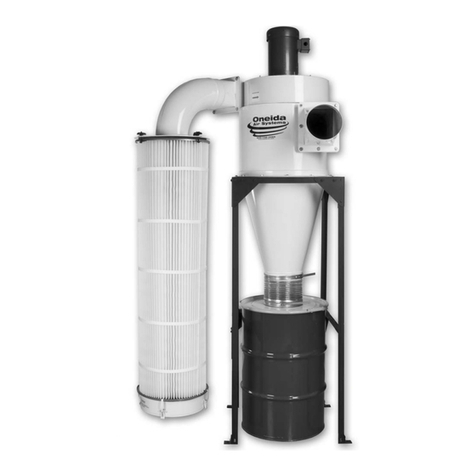
Oneida Air Systems
Oneida Air Systems Pro 2000 owner's manual
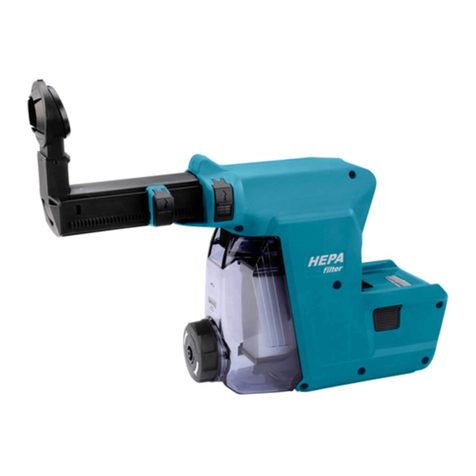
Makita
Makita DX06 instruction manual

Oneida Air Systems
Oneida Air Systems V1500 owner's manual
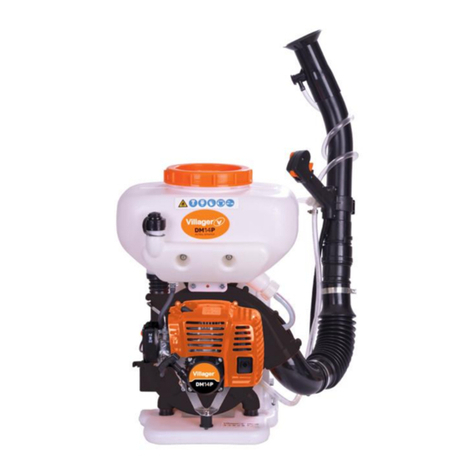
Villager
Villager DM 14 P Original instruction manual

Shop fox
Shop fox SHOP FOX D3756 instruction sheet
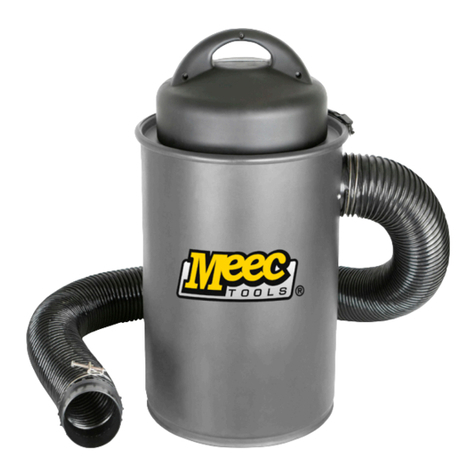
Meec tools
Meec tools 005416 operating instructions

Jet
Jet JCDC-2 operating instructions
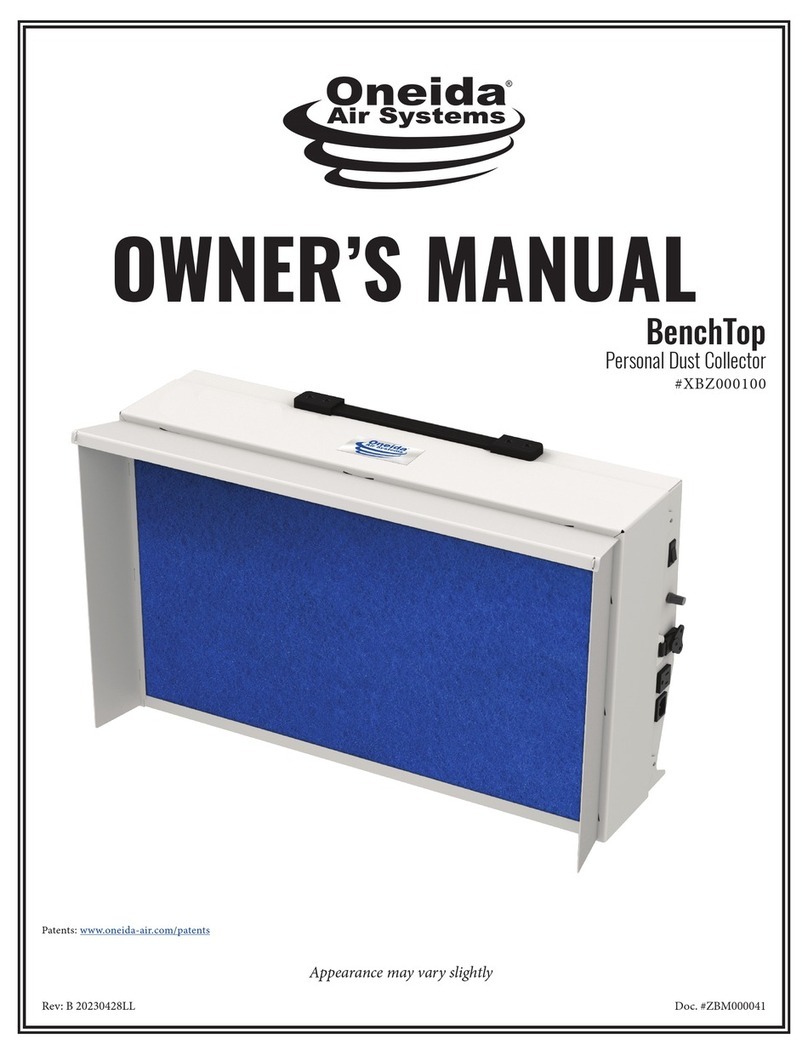
Oneida Air Systems
Oneida Air Systems BenchTop owner's manual
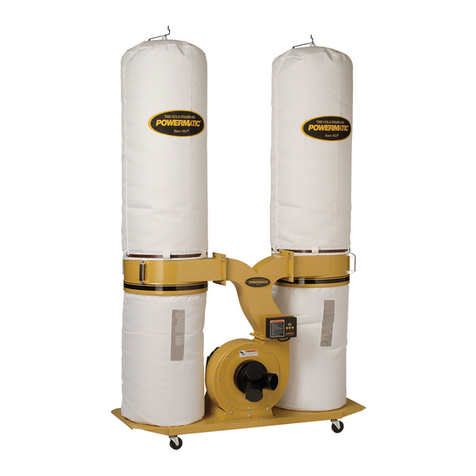
Powermatic
Powermatic PM1900TX Instructions and parts manual

Shop fox
Shop fox W1727 owner's manual
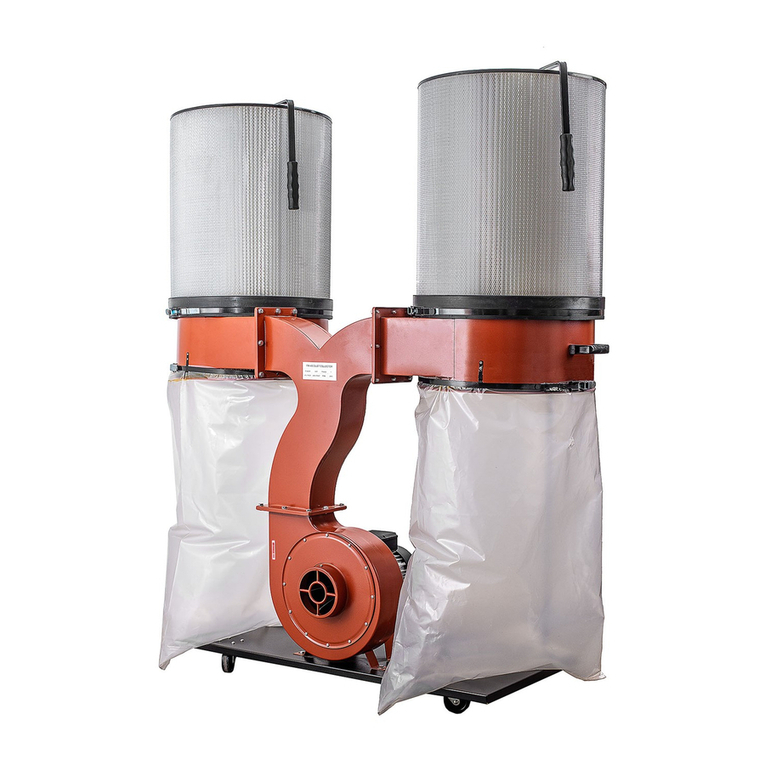
Timbecon
Timbecon DC2200 instruction manual
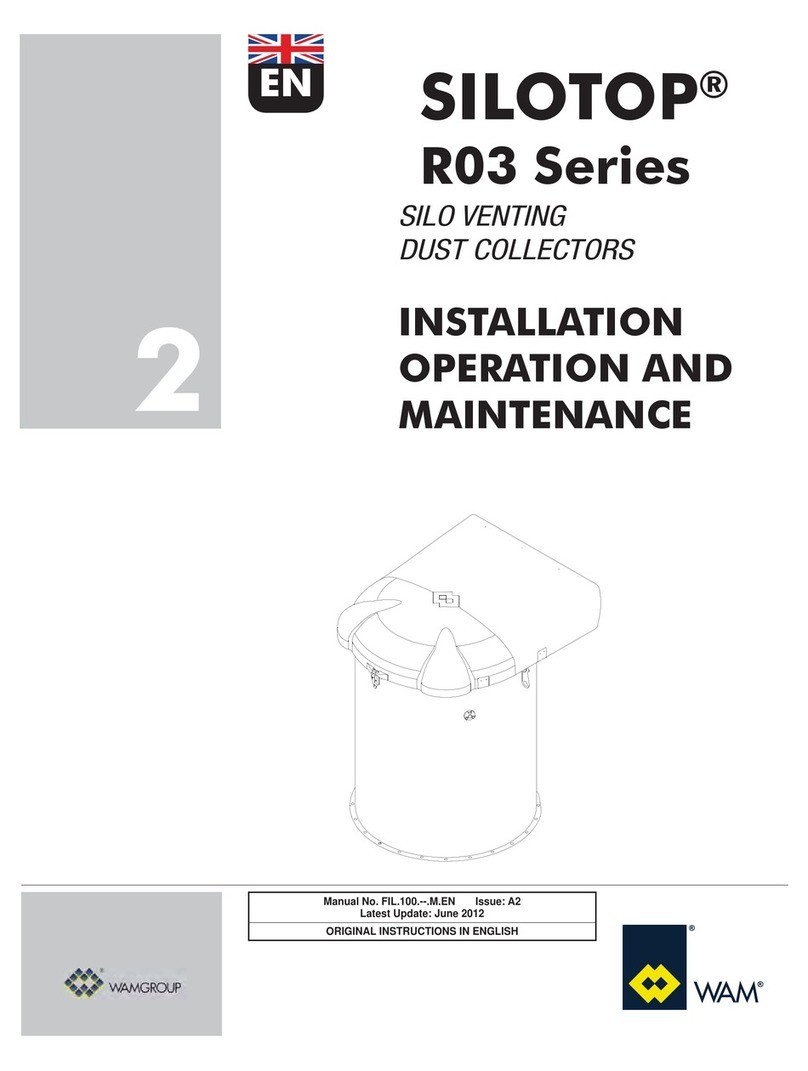
WAMGROUP
WAMGROUP SILOTOP R03 Series Installation, operation and maintenance
